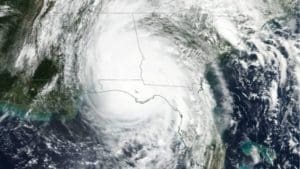 By Joe Capers, Insurance Zone
By Joe Capers, Insurance Zone
With 70% confidence, NOAA (National Oceanic & Atmospheric Administration) has just released its 2022 Hurricane Season Forecast calling for an above average season with 14 to 21 named storms. Last year’s 21 named storms was the second season in a row – third overall – in which the designated 21-name list of storm names was exhausted. NOAA forecasters estimate 14 to 21 named storms, six to 10 of which will become hurricanes, with three to six of those developing into major hurricanes.
The 2022 Atlantic hurricane season runs from June 1 to November 30. The areas covered include the Atlantic Ocean, Gulf of Mexico and the Caribbean Sea. The National Weather Service defines a hurricane as a “tropical cyclone with maximum sustained winds of 74 mph (64 knots) or higher.” And in recent years, storms have grown increasingly intense.
If you own a home, investment property or business, you are probably aware that having the right homeowners, rental and business insurance policies in place are of utmost importance. Without proper coverage, you could be responsible for expensive damage in the event of a weather-related incident. In fact, as this year’s hurricane season kicks off, now is a really good time to review your insurance policies and make sure you are satisfied with your level of coverage.
 We recommend you initially review your Hurricane/Wind coverage. Most personal lines policies (HO3, DP3, HO6, HO4) in Florida include either hurricane, named storm or wind/hail under a separate deductible. Consistency of coverage is important in any policy, but this type is typically preferred. When it comes to wind coverage, the best option is to attempt to secure it on a Hurricane basis, rather than Named Storm or Wind/Hail. Keep in mind there are several deductible options available that can have a large impact on what would be your out-of-pocket responsibility if you file a claim as well as the amount of premium you would pay for the policy.
We recommend you initially review your Hurricane/Wind coverage. Most personal lines policies (HO3, DP3, HO6, HO4) in Florida include either hurricane, named storm or wind/hail under a separate deductible. Consistency of coverage is important in any policy, but this type is typically preferred. When it comes to wind coverage, the best option is to attempt to secure it on a Hurricane basis, rather than Named Storm or Wind/Hail. Keep in mind there are several deductible options available that can have a large impact on what would be your out-of-pocket responsibility if you file a claim as well as the amount of premium you would pay for the policy.
In last month’s article, we discovered that inflation may be leaving you more underinsured. Adequate Dwelling and Building Limits coverage to rebuild your home or structure in the event of a loss is also important. Local and national data indicates that nearly two out of three homes and structures are underinsured.
The cost of lumber and other common building materials has soared in the past year as a result of supply chain disruptions and shortages, and this is the main reason new home construction has grown more expensive in recent years. As such, the homeowner and insurance policies that were once sufficient for your property might now fall short.
Another important coverage to review is Loss of Use that pays for you to live somewhere else while repairs are being done to your temporarily unlivable home. This also goes for rental properties with Loss of Rents coverage. To trigger this type of coverage, there needs to be direct physical damage.
An often misunderstood coverage not offered with each carrier, but always recommended, is Law or Ordinance coverage. Most carriers, if they have it available, offer either 10%, 25% or 50% coverage tied to your Dwelling or Building Limit. If there is extensive hurricane damage, like we saw with Hurricane Michael, there might be new building codes you must adhere to in order to rebuild. The additional Law or Ordinance coverage is crucial to your protection, since your policy is designed to rebuild your home as it was before the damage, with similar materials and quality, and not with more costly materials that could now be required by more stringent construction codes that may have come into play.
Our coastal properties are threatened by hurricanes and tropical storms each year, and flooding can happen anywhere, anytime—even in non-flood prone areas. We encourage everyone to purchase flood insurance from the National Flood Insurance Program (NFIP), or a reputable, private flood insurance facility which may be a better flood insurance alternative to the NFIP for your home, investment or commercial property.
It is also good to remember that flood and water damage from a wind event are not necessarily the same thing. There are a few carriers who will add flood coverage as an endorsement to a home policy. For most insured homeowners, your flood policy will be a separate policy written through the NFIP (National Flood Insurance Program) or a private market, and this is the method we prefer. Unless your lender requires the policy, or you are closing on a new purchase, there is a standard 30-day waiting period through the NFIP before your flood policy will become effective. Many of the private markets in the country, and especially in Florida, offer broader coverages than the NFIP and these should be considered as an alternative to maximize your protection.
The insurance marketplace continues to deteriorate with premiums increasing, guidelines and appetites tightening and some carriers losing the ability to offer new coverages and renewals. According to the Insurance Information Institute, property insurance premiums in Florida are expected to jump 30-40% on average in 2022, with many likely seeing renewal increases well over 50%. Citizens Property Insurance Corporation, the state’s insurer of last resort, is again becoming a popular and vital player in Florida. Although Gov. Ron DeSantis just signed two pieces of legislation during the special session focused on insurance reform, there’s nothing in this legislation right now that’s going to provide immediate relief, or even the hope of some rate relief for a year or two.
 Insurance Zone, founded by Joe and Lea Capers, is a full service commercial and personal lines insurance agency serving Destin, Miramar Beach, Santa Rosa Beach (30A) and Inlet Beach. Visit the Video Library on www.ins-zone.com and watch several informative videos on ‘Homeowners, Condo Unit Owners and Flood,’ or call 850.424.6979 and talk with one of our experienced Team Members.
Insurance Zone, founded by Joe and Lea Capers, is a full service commercial and personal lines insurance agency serving Destin, Miramar Beach, Santa Rosa Beach (30A) and Inlet Beach. Visit the Video Library on www.ins-zone.com and watch several informative videos on ‘Homeowners, Condo Unit Owners and Flood,’ or call 850.424.6979 and talk with one of our experienced Team Members.
























































